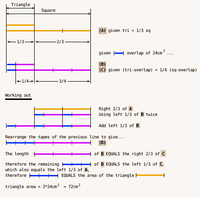senseimichael
New member
- Joined
- Mar 11, 2020
- Messages
- 44
The figure is made up of a triangle and a square. The area of the triangle is 1/3 the area of the square. After the overlapping part of 24 cm² is cut out, the remaining area of the triangle is 1/4 the remaining area of the square. Find the area of the triangle.

We cannot use algebra, because Grade 5 kids have not learnt this yet. They have already learnt the area of triangle and area of square, as well as fractions and ratios.
How I started working this out:
1. I got the ratio of T:S to be 1:3.
2. After cutting out the 24cm2 from both, we get a ratio of 1:4.
3. So 4 units = 5 units - 24cm2, so 1 unit = 24cm2
4. So the triangle should be 24cm2, which is (logically speaking) TOTALLY WRONG!
Every bit of my mathematical fibre is telling me this is wrong!
The answer key for this question is 72 cm2.

We cannot use algebra, because Grade 5 kids have not learnt this yet. They have already learnt the area of triangle and area of square, as well as fractions and ratios.
How I started working this out:
1. I got the ratio of T:S to be 1:3.
2. After cutting out the 24cm2 from both, we get a ratio of 1:4.
3. So 4 units = 5 units - 24cm2, so 1 unit = 24cm2
4. So the triangle should be 24cm2, which is (logically speaking) TOTALLY WRONG!
Every bit of my mathematical fibre is telling me this is wrong!
The answer key for this question is 72 cm2.


